< Homepage >
Llewellyn Jones of Pontycymmer – His Life & Achievements
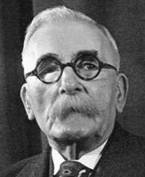 My Great Grandfather, Llewellyn Jones, was born on 13th Sept 1868 in the village of
My Great Grandfather, Llewellyn Jones, was born on 13th Sept 1868 in the village of
Llantwit Fardre, in Glamorgan, South Wales. This is the story of his career from colliery
blacksmith to secretary or chairman of many of the Garw Valley’s societies.
Llewellyn’s mother, Mary Williams, was a dressmaker who had been born in nearby
Pentyrch. Mary's father had been a labourer in an iron works and her mother became an
inn keeper in Cross Inn, near Llantwit Fardre.
Llewellyn’s father, Elias Jones, had been born in Blaen Penal, Cardiganshire, and had
moved with his family to Llantwit Fardre by the mid 1860’s. Elias was a miner called a
‘sinker’ (a skilled miner who sank new shafts).
Elias’ father was another Elias Jones who had been a Tailor. He sadly died of tuberculosis
when his son Elias was a baby, and his wife had managed on poor relief until she re-married.
This elder Elias' father had been David Jones, a hatter from Blaenpennal.
1871
Llewellyn (age 3) appears on the 1871 Census (recorded on 3rd April) living with his parents, Mary and Elias, and his 2 month old brother David, in Cross Inn village near Llantwit Fardre.
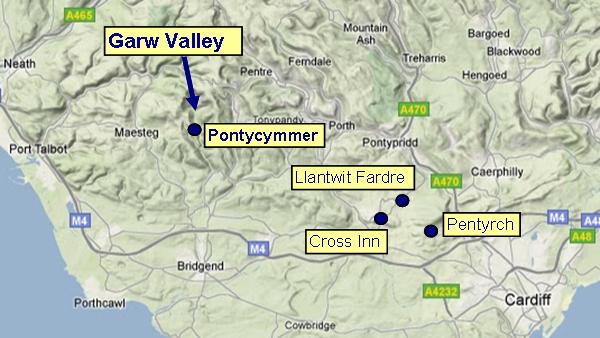
Llewellyn’s parents moved to Pontycymmer around 1880, when the Ffaldau and other collieries were opening as a result of the new railway line having recently been extended to the end of the Garw valley.
The population of the valley had been less that 100 people ten years earlier. By 1881 it had grown to almost 1000 (and ten years later was over 5000) [1]. House building had to keep up and the majority of the growth happened between 1876 and 1899 as recorded on the < Ordnance Survey maps > for those years.
This huge population growth occurred as more mines were opened up in the valley until there were ten operating at the peak. The locations of the different pits in the Garw Valley are shown below (from OS maps for 1884, 1900,1921 and 1948):
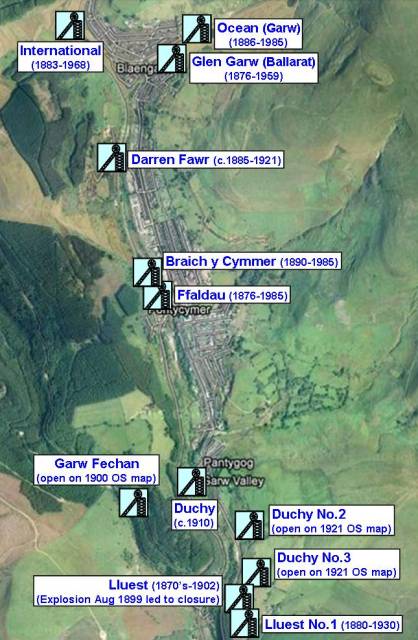
The economic growth was not continuous over the period from 1880 to the 1st World War as there were many periods of boom and bust. In the good times wages would rise, but they would also fall and jobs would be lost when trade in coal slackened. The Garw was partially protected from the extremes due to the high quality of the coal which resulted in large orders from the Admiralty for their fleets of steamships.
1881
According to the 1881 Census, Llewellyn (age 13) was living in Pontycymmer with his parents and his younger brother David. His father Elias was listed as a miner, as are most of the others in the street, but their neighbour was a Police Constable (Hugh Llewellyn) and next to him was an Assistant Surgeon, Thomas Lloyd.
The census listed Llewellyn as a teacher – elsewhere described as a 'monitor' or 'pupil teacher' at a makeshift miner's school opened by coal owners and miners at a local chapel. The background to this is described by A. H. Williams in his 'Garw Valley, A Short History 1850-1950' [0] .
"During those days the nearest Post offices was at Blackmill in a neighbouring valley about four miles from the town of Pontycymmer. The mail was brought to Pontycymmer by a postman named Michael Doolan an Irishman. Michael used a donkey for his round and in his spare time he started a school in the big kitchen beneath the shop of a Mr. Thomas Bale ... As the number of children increased Mr. Doolan was forced to move his school to the vestry of the Wesleyan chapel where he instated the “monitor system” which continued in the chapel until the first school the “Ffaldau”, in 1900.
An account of Education in the Garw valley would not be complete without mentioning one of the outstanding characters of the community. Llewellyn Jones J.P. was one of Michael Dolan’s monitors in the vestry of Bethel Chapel and he stayed on for a number of years until he was forced to leave for financial reasons."
This was one of the boom times in the valley, following a recent depression, and miners wages were increased by 2.5% [1]
1883
On December 31st 1883, Llewellyn lost his younger brother David who died at the age of 13. He suffered from an intestinal disorder (Intussusception) according to the death certificate registered on the next day. He was described on the certificate as the 'son of Elias Jones - a pit man'.
1884
Llewellyn continued as a pupil teacher for 3 years until 1884 when he became an apprentice blacksmith at the Ffaldau Colliery. He remained a blacksmith for 30 years, eventually becoming a foreman. While he was an apprentice he made an elaborate brass kettle stand which is still in the family.
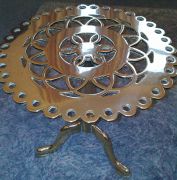
In 1884 there were 1,310 miners working in the Garw, 270 of whom were 'sinkers' digging the new mine shafts [1]. Llewellyn's father Elias (now 44) was one of these skilled sinkers.
Although the railway had been running in the valley since 1876 it only carried coal and there was no passenger service (to Bridgend) until 1886. In the years leading up to this, the isolated community advertised for businesses to come to the valley. The Glamorgan Gazette in November 1885 carried an advert describing the valley as a place with "opportunities for an energetic tradesman to develop a large and lucrative business". A number of the larger Bridgend stores also opened branches in Pontycymmer to ensure access to the expanding but isolated commercial market.
1886
At the age of 18 Llewellyn joined the Rose of Garw Lodge of Oddfellows which was in decline and only had 30 members, most of whom were elderly. He quickly took on the role of secretary and over the following years progressed to higher offices and helped grow the lodge membership (see below entry for 1916).
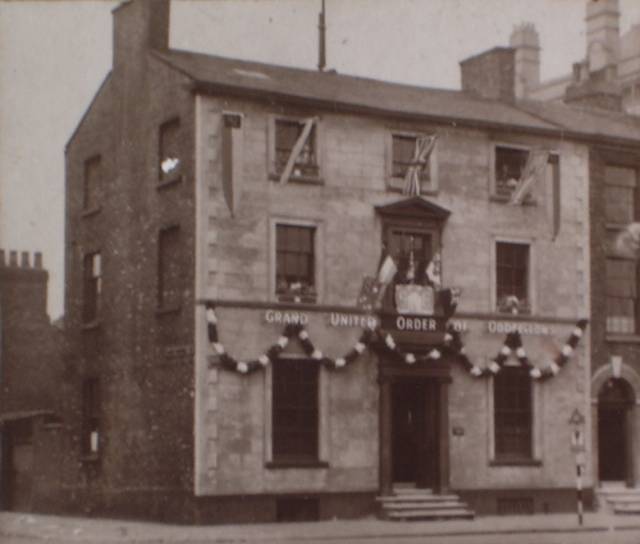
According to their literature, the Oddfellows had originated from the trade guilds of the Middle Ages that consisted of Apprentices, Journeymen or Fellows (paid skilled workers) and Masters who ran the businesses. As trade grew in the 14th Century, the Masters became richer and were not inclined to pass their positions on to the best Fellows, but to their own heirs instead. In protest, the Fellows started to set up their own rival 'Yeoman Guilds'. In the smaller towns there were not enough members of an individual trade to form a guild, hence the formation of 'Oddfellows' Guilds combining an odd assortment of trades.
During the following centuries, due to fears of the Guilds' potential to organise against authority, they became ever less acceptable and most had their money and control taken away. By limiting their activities to only providing financial support for their members, the Oddfellows were one of the few to survive. The Grand United Order of Oddfellows was formed in 1798. By the time Llewellyn joined they had lodges all over the UK and provided health and unemployment insurance for many 100,000’s of individuals at a time when there was no alternative state aid.
1886 was also one of the years of slow trade in coal with only the Ffaldau and Ocean collieries working close to fulltime. Elsewhere trade was described as being at a virtual standstill.
1889
Llewellyn's father Elias died on 4th December 1889 at the age of 49. The death certificate records the cause of death as “tubercular laryngitis” which was associated with tuberculosis – the same disease his father had died of. Llewellyn was present at the end and signed the death certificate. The Probate records show that Elias had become a 'Colliery Repairer' before his death and that he left £263 1s 8d to his wife Mary.
Their address was 18 Alexandra Road, Pontycymmer.
1890
In July 1890 Llewellyn married Anne Williams and their marriage was registered in Bridgend. He was 21 and she was 22, the daughter of John and Alice Williams.
John Williams was from Llanelly and Alice had grown up in Brynaman. They had both moved to Maesteg where they had met and married before moving to Lluest, south of Pontycymmer, where John had been a coalminer.
They had a very large family and Anne was the third of 9 children.
I have traced John Williams's ancestry back to a sailor (Thomas Williams) from Minehead who sailed during the period of the Napoleonic wars and, through Thomas' wife, back through Somerset families to the mid 1600's - my oldest traceable ancestors - and the only English ones. See < Anne's Family Tree > for more details.
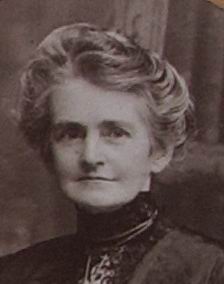
1891
The 1891 Census records Llewellyn (age 22) as a colliery blacksmith living at no.18 Alexandra Road, Pontycymmer with his mother and new wife Anne & two lodgers.
There is a story that may have had it's origins around this time, that one of the colliery lift cages got stuck in the shaft. It seems that Llewellyn climbed down and hung over the shaft, holding on with one arm while freeing the blockage with the other. The years of blacksmithing had clearly made him strong.
By 1892 over 20,000 tons of coal was being mined and transported out of the valley every week, over half of this from just two mines - the International and the Ocean [1] .
1892
Elias John Jones - Llewellyn and Anne's first child - was born in 1892.
1895
Arthur Llewellyn Jones - their second child - was born on 20th November 1895. The birth was registered in Ogmore on 1st January 1896 by Anne. The certificate recorded Llewellyn as a Blacksmith (Journeyman).
1898
Brinley William Jones (my grandfather) was born on 22nd May 1898.
1900
Towyn David Jones was born in September of 1900
1901
In the 1901 Census Llewellyn continues to be described as a colliery blacksmith, still living in Alexandra Road with Anne and their four children. Also living with them was Hannah Williams (Anne's sister), working as a domestic servant.
Just a few months after the census, Towyn sadly died on 26th August at just 11 months old.
1902
Llewellyn became one of the founder members of the Pontycymmer Cooperative Society and later he was to spend 30 years as a director. He was particularly proud when the annual sales reached the million pound mark and earned it the title ‘Millionaire Coop’.
1905
Llewellyn was first elected to represent Pontycymmer on the Garw Urban District Council, a position he held unbroken for 33 years during which he was 3 times chairman. On his retirement he presented a gold chain of office for future chairmen & women.
1906
This picture was taken in 1906 showing the Ffaldau colliery:
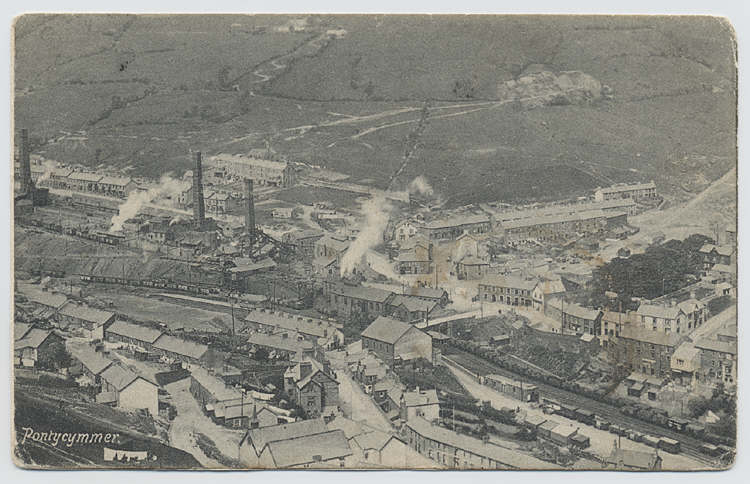
The following was written about the Ffaldau Colliery: [2] "At the turn of the century the Ffaldau was firmly established and was continually introducing intricate technology to maximise production. The colliery management adopted such innovations as the Belgian Coke Ovens, the first of their kind in S. Glamorgan, and the Siemens-Shuckert aerial ropeway which removed waste from the colliery site to the hill-top directly above. The introduction of technological innovations became commonplace in the 20th century and virtually turned the colliery into an industrial guinea pig."
Llewllyn, as the blacksmith, must have been heavily involved in this growing use of mining technology.
1907-1909
1907 and 1908 were good years for coal production in the valley. The Ffaldau colliery had made a heavy investment in developing the '7-foot seam' and this paid off during the boom. Wages increased and so did union membership. With coal tax being removed in 1907 the volume of trade increased again, and previously closed collieries (like Braichycymmer) were re-opened. The local economy became buoyant and wages again went up.
As usual, however, the boom caused over-production followed by a fall in trade as demand decreased.
By 1909 the owners were again insisting on a reduction in wages due to the reduced profits. This cycle of boom and bust is clearly illustrated by the profit history of the International Colliery [1]:
|
1905 |
1906 |
1907 |
1908 |
1909 |
|
£8153 |
£6,999 |
£23,657 |
£27,142 |
£3,105 |
1911
The census for 1911 records Llewellyn still working as a blacksmith and still living at 18 Alexandra Rd with Ann and their sons Arthur (15) and Brinley (12). Elias John was now 19 and no longer living at home.
In 1911 Asquith's Liberal government introduced the National Insurance Act, basing their calculations on Oddfellows actuarial tables. The Oddfellows role then changed to include helping administer the state pension benefits until 1946 and Llewellyn played a major role in this activity.
1913
By 1913 the Garw Valley Medical Aid Society had been created and registered as a Friendly Society and it was formally voted for by the miners of the Garw Valley in January, as reported in the Glamorgan Gazette [3]:
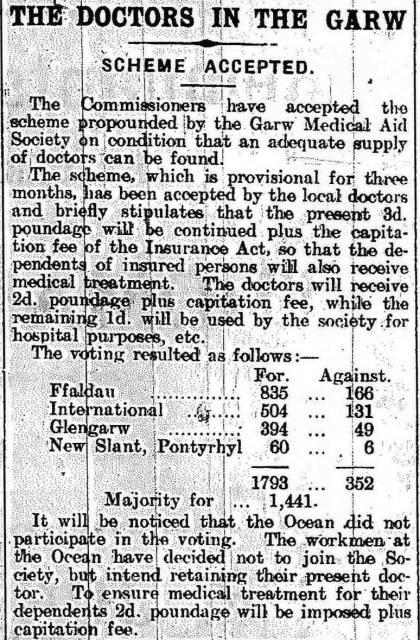
Llewellyn was appointed as secretary of the Society from the start and he retained this position until the Society was incorporated into the newly formed National Health Service in 1948.
A local resident (Ann Evans) remembered the Society in her "A Child of the Valley" account [0]:
"Most people belonged to The Medical Aid Society and my father paid a few shillings a week for this wonderful service. If we were ill, we could attend the surgery behind the Ffaldau Institute that could be reached by steps from Oxford Street, or also by a narrow lane."
As related in Vernon Chilcott's book [4] retaining the doctors that were needed for the Aid Society was not easy in the face of determined opposition from the British Medical Council which "constantly put pressure on doctors to dissuade them from working for such societies. On one occasion two of the three doctors decided to resign. Advertisements to fill their places met with no response so Llewellyn and a fellow member of the committee hired a car and for 3 days scoured the valleys and towns of South Wales for replacements. With the outbreak of WW1 the BMA decided to lift the ban on the Society."
1914
Llewellyn gave up being a blacksmith in1914 because of his involvement in the many societies of which he had now became the secretary or chairman. This year he also became a magistrate in Bridgend, a position he continued to hold for over 30 years.
Llewellyn was also an active member and deacon at the Tabernacle Chapel.
An interesting commentary on life in the valley is provided in Merlin Maddock's book 'Whilst the Valley Sang' [5] where he notes that "Up until the decline in the mining industry, it was a well established fact that to get employment in the mines you attended Bethel Welsh Methodist Chapel, where the colliery managers, under-managers and officials were deacons. To be employed in the Co-operative Society or the Ogmore and Garw Council you attended Tabernacle Welsh Independent Chapel ... children were encouraged by their parents to attend Sunday Schools of the above chapels and be noticed by the deacons". I'm sure Llewellyn would have upheld this 'patronage' or 'jobs for the boys' tradition!
1916
An article in the Glamorgan Gazette in April 1916 mentioned the Medical Aid Society and the opening of a new surgery in Blaen Garw:
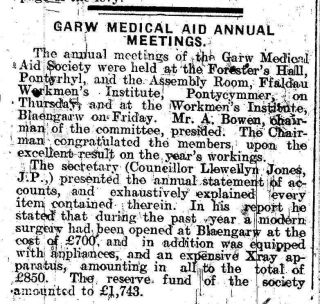
As mentioned previously, following Llewellyn's appointment to the Rose of Garw Oddfellows Lodge, it became very successful and grew to become one of the largest lodges in the country with a membership of over 2,300.
As a result of this Llewellyn had progressed steadily within the Oddfellows until, in 1916, he became the national Grand Master of the Oddfellows - a great honour in those days.
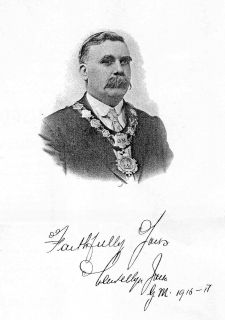
A copy of the Oct.1916 Oddfellows magazine, describing Llewellyn's appointment and his long list of achievements and leadership roles up to this date, can be viewed here: < magazine >
On his return from his installation in Lancaster, a cheering crowd met him at Pontycymmer station and he was driven home in an open carriage headed by the Pontycymmer Silver Band.
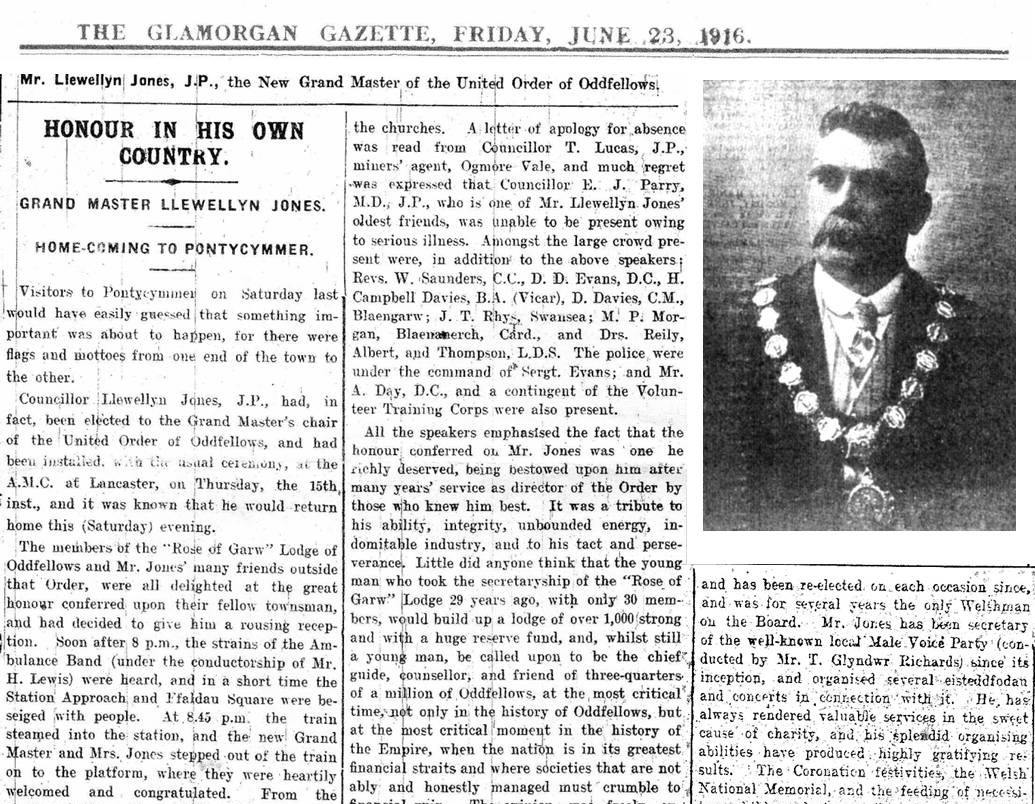
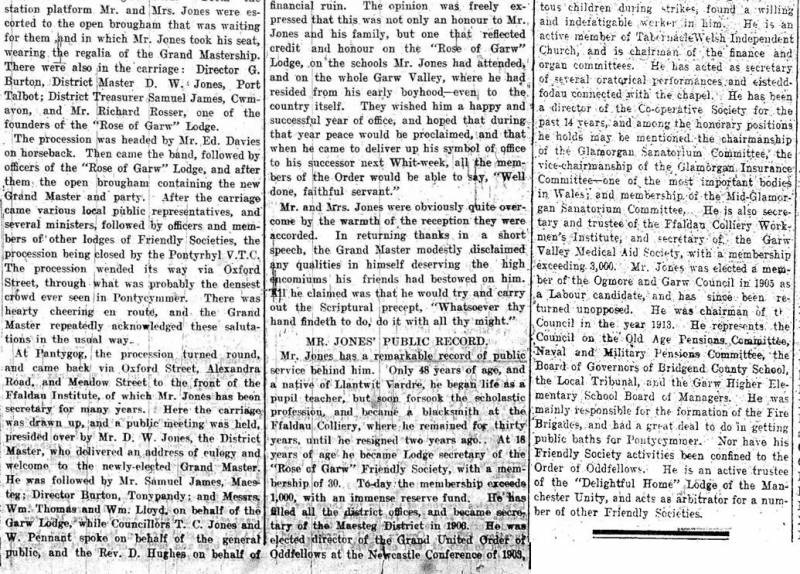
Due to the disruption caused by the First World War, Llewellyn unusually retained this office for 3 years until 1919.
Sometime between 1911 and 1916 Anne and Llewellyn adopted a baby girl called Nancy after her mother had died in childbirth.
1917
Llewellyn’s second son Arthur was killed in Palestine on 7th May 1917. Arthur had served in the Royal Army Medical Corps since enrolling in Swansea at the start of the war. He had served at Sulva Bay in Galipolli and then Egypt and finally Palestine, where he was killed instantly by a shell landing in his dugout just after the 2nd battle for Gaza.
Arthur's death was reported in the Glamorgan Gazette, including excerpts from a letter written to Llewellyn and Anne explaining what happened. They must have been desperately upset, and they received many letters and telegrams of sympathy.
In September Llewellyn wrote to the army requesting Arthur's possessions which they returned to him: a pocketbook, a New Testament, letters and postcards and a wallet containing a photo. A few years later Llewellyn also signed to receive Arthur's three service medals.
For further details of Arthur's life and military service see: < Arthur Jones Story>
1917-1920
Taken sometime before 1917, this view across the valley shows the Ffaldau Institute and Medical Aid buildings in the foreground, with Ivor and Richard streets running up to the right (the top of Ivor Street, where Llewellyn soon went to live, is yet to be finished). The Tabernacle Church that Llewellyn belonged to is the large building lower left, and the road at the far left is the top end of Alexandra Road, with the cemetery on the hill (where Llewellyn is buried). There is a modern aerial view of this part of the town in the section 'my memories of Pontycymmer'.
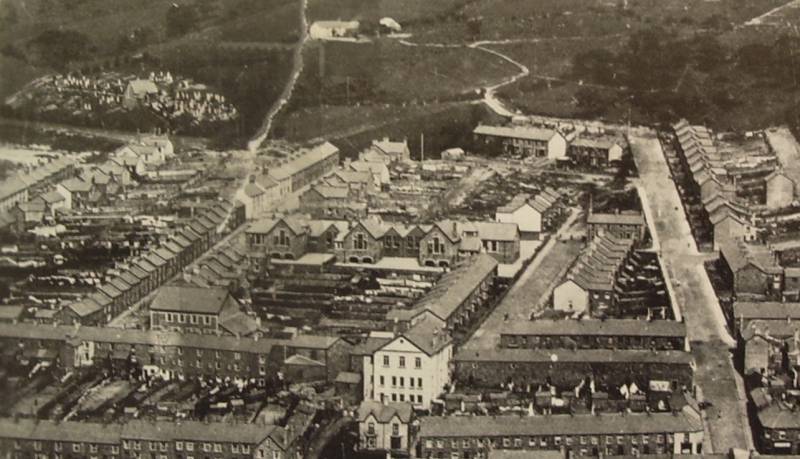
The picture below shows a view down Ivor Street with the Ffaldau Institute at the bottom. Llewellyn was secretary of the Institute which was built in 1901 and provided a key social focus for the local community. Just behind the Institute was the building that housed the offices of the Garw Valley Medical Aid Society. The end of the Junior School (that my father attended) is on the right.
Around the beginning of 1919 [6] Llewellyn moved from Alexandra Road to a newly built house called Brynderwen at the top of Ivor St. (below, right) so he must have walked up and down this remarkably steep hill quite a few times! Brinley (now 21) was still living with his parents, but Elias John (now 28) was living just down the road at no. 18 Ivor Street.
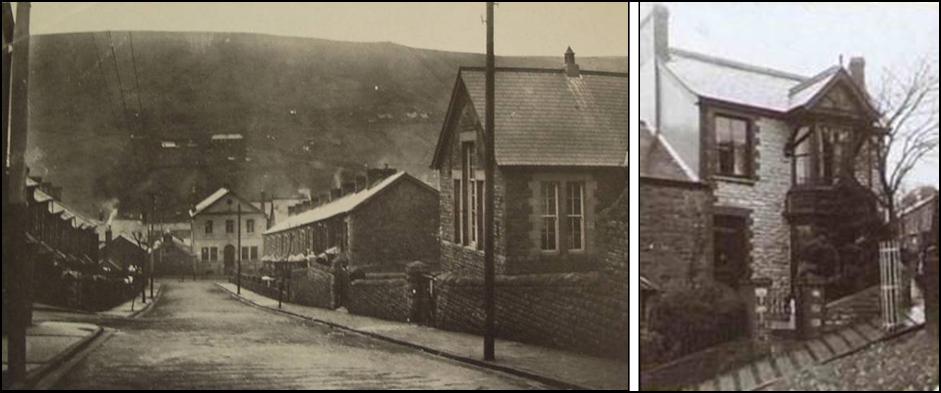
1920's
During this period, and into the early 30's, Llewellyn would have been kept very busy with all the societies and committees but he also found time to take his family on holidays. There are a number of pictures of him at Porthcawl with his family and as here 'out with the lads':
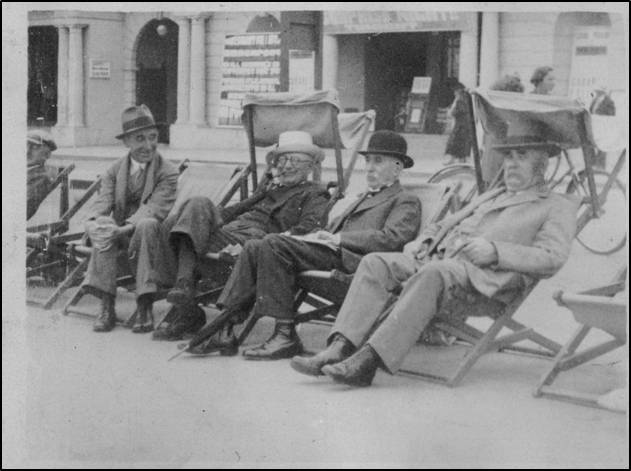
At some point he also managed to sail on the American liner SS Leviathan, probably in the late 20's, with his wife and other family members including his adopted daughter Nancy. Presumably they visited her in Southampton or maybe sailed across to France and back (I can't imagine they could have afforded a voyage to New York)
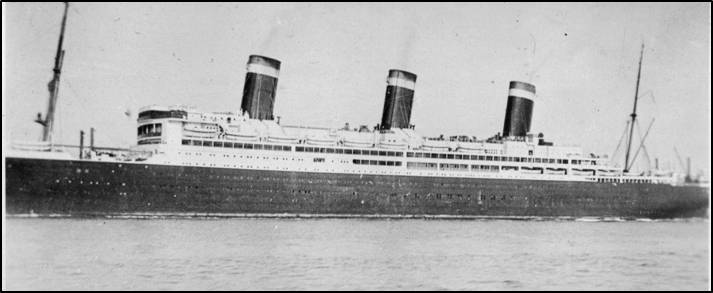
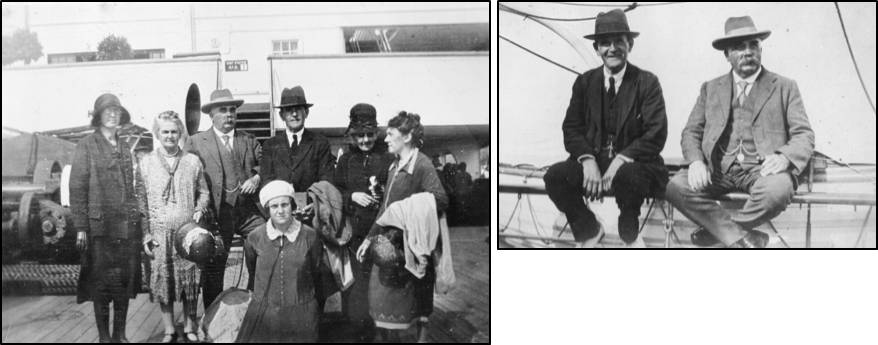
1929
Llewellyn was elected again to represent the Pontycymmer Ward in the Urban District Council Elections in 1929.
He was returned by the people of Pontycymmer for an un-broken period of 33 years.
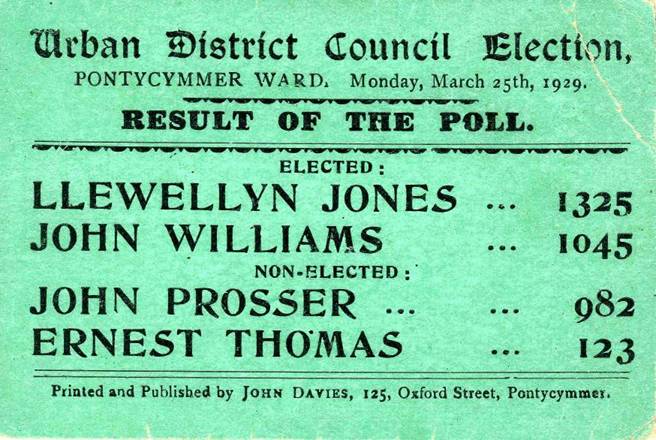
1938
Llewellyn's wife Anne sadly died on 12th July 1938 at the age of 71. My father remembers that his mother's funeral procession included many hundreds of Pontycymmer residents showing their respects to her.
1939
Llewellyn was honoured by the ‘Inhabitants of the Garw Valley’ with an illuminated manuscript detailing his achievements.
These included his involvement in many educational and social societies. He was a governor of the Garw Secondary School, the University College Cardiff and the Bridgend and Garw Secondary Schools. He was also secretary and trustee of the Memorial Hall in Pontycymmer where a number of famous artists performed. He was also Deacon and Secretary of the Tabernacle Congregational Church.
A composite picture of his family was created for the illuminated manuscript, including pasted-in older pictures of his wife and son Arthur:
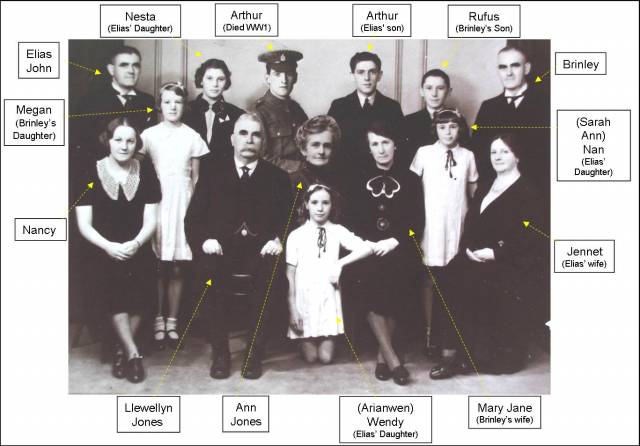
Llewellyn retired in 1939 as a member of the Ogmore and Garw Council. He had been a member for 33 years and Chairman for three of those. On 31st March, the Glamorgan Gazette recorded a ceremony at which Llewellyn presented a gold chain of office for future chairmen.
Llewellyn was still a magistrate in 1939 and as can be seen from the cutting below, on some occasions he had to deal with some pretty serious crimes!
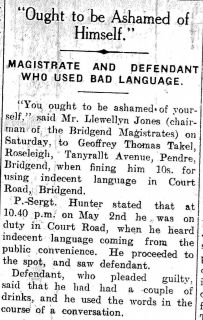
1943
Wings for Victory Appeal - Llewellyn appeared here on the platform with Ted Williams (MP) helping to persuade people to buy bonds to help pay for more aircraft for the RAF.
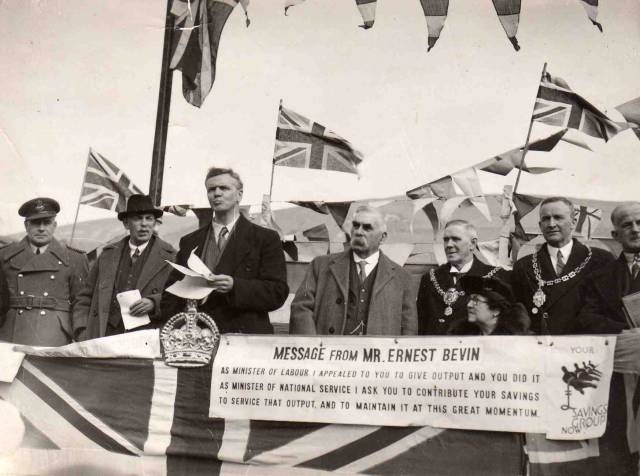
1948
At the launch of the National Health Service in 1948, Mr. Aneurin Bevan, Minister of Health, paid tribute to Llewellyn and the Garw Medical Aid Society, by appointing him the first chairman of the Glamorgan N.H.S. Executive Council.
Due to the 35 years of experience that Llewellyn had built up as secretary of the Garw Medical Aid Society, Aneurin had consulted with Llewellyn to seek his advice before setting up the NHS. They held many meetings at the Sea Bank Hotel in Porthcawl [5] and my father remembers meeting Aneurin at Llewellyn's house.
When the NHS was inaugurated, the Medical Aid Society was wound up and the remaining funds were distributed between local hospitals and other deserving organisations.
1950
In a short history of the Garw Valley written in 1950 [0] , A H Williams wrote:
"Llewellyn Jones J.P. ... became a blacksmith at the Ffaldau Colliery and devoted all his spare time to welfare work. He acted as secretary to the trustees who, with the aid of the S.W.M.F. built the “Ffaldau Institute”. He initiated the Medical Aid Scheme in 1910 and still took an active part in the Scheme until it was absorbed into National Health Service. He also carried on with the Chairmanship of the “Rose of Garw” Friendly Society which was started at the Ffaldau Colliery in 1884. Today he is still secretary of the Ffaldau Workingmen’s Institute and he still takes his place on the Bench at the local petty sessions. He is a man to whom everyone in the valley is, in some way, indebted and a man whom everyone respects. Llewellyn Jones J.P. has served for many years in the Local Government Services as a County Councillor. He has helped in the administration of the Garw Valley and even though he cannot devote the whole of his time nowadays his work is being carried on in the same tradition by his son (Elias John) who is clerk to the Urban District Council."
1953
Llewellyn died, at the age of 85, on the 18th February 1953.
A number of tributes appeared in the Glamorgan Gazette for February 20th and 27th:
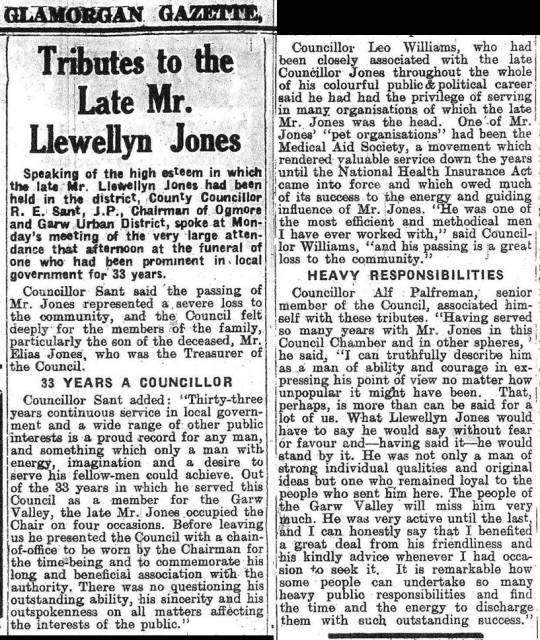
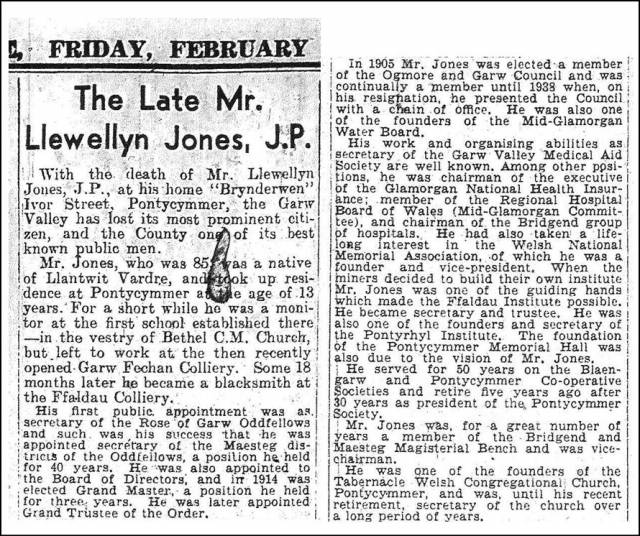
Llewellyn Jones certainly made his mark in the Garw and I'm proud to be descended from someone who worked so hard to try and improve conditions for those living in the Valley.
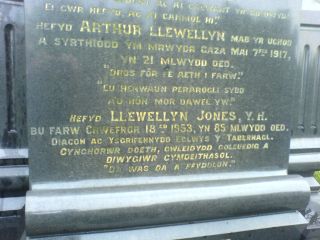
Sources:
[0] "A Short History of the Garw Valley – 1850 / 1950", A.H.Williams – August 1950. http://www.garwheritage.co.uk/wordpress/?p=678&cpage=1
[1] Aspects of Urban History of the Garw Valley, 1870-1914, PhD Thesis, Wyn Price, 2001, p117. Held at Local & Family History Collections, Bridgend.
[2] Garw Valley - Official Guide 1994, p26. Held at Local & Family History Collections, Bridgend, ref. L450
[3] Glamorgan Gazette - microfilm copies held at Local & Family History Collections, Coed Parc, Park St., Bridgend, CF31 4BA.
[4] Vernon Chilcott - They Made Light of Their Darkness, Valley & Vale, 1994, chapter on 'The King of the Garw' about Llewellyn Jones
[5] Merlin Maddock - Whilst the Valley Sang, 2009, p50
[6] The date of moving is confirmed by letters sent back and forth to the Army regarding Arthur's death.
July 1818 letter went to Alaxandra Rd, July 1919 letter went to Brynderwen. Found through WW1 records on www.ancestry.com
[7] Census returns for the Garw Valley from www.ancestry.com
Links:
Interesting Garw Valley heritage site: http://www.garwheritage.co.uk/wordpress/
History and pictures of many of the mines in the Garw Valley: www.welshcoalmines.co.uk
Pictures of the Garw today and forum: www.garwvalley.hyak.co.uk
Excellent modern pictures of the Garw Valley: www.merlin-the-wizard.freeserve.co.uk/cwmgarw/cwmgarw.html
 My Great Grandfather, Llewellyn Jones, was born on 13th Sept 1868 in the village of
My Great Grandfather, Llewellyn Jones, was born on 13th Sept 1868 in the village of




















